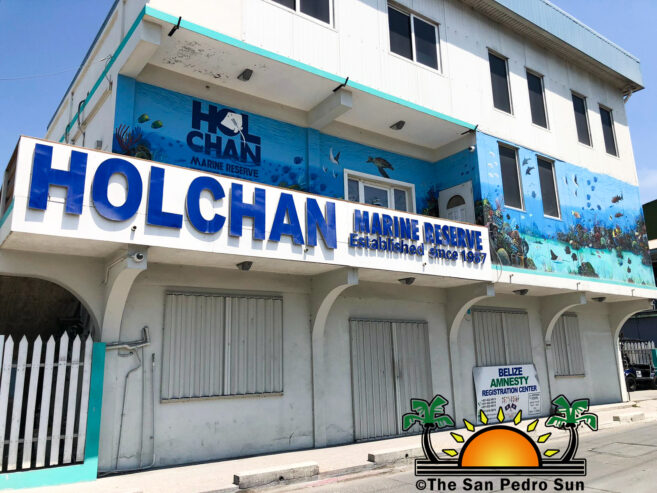The beaches of San Pedro, Ambergris Caye, as those across the country, are again choking with the heavy influx of the brown algae known as Sargassum. It has become an inconvenience making the shoreline unattractive with the rotten seaweed and threatening the local tourism industry. The Hol Chan Marine Reserve (HCMR) is securing a $3.5 million loan from the Social Security Board (SSB) to address the situation. Some consider this move by HCMR frivolous and that the Government of Belize should bear the expense. The Hol Chan management, however, explained the need for the loan and what the project was all about.
The controversy started when the loan petition was published in a local newspaper. According to the public notice of investment by the SSB, the $3.5 million is to facilitate HCMR in obtaining and installing Sargassum barriers and for capital expenditure. HCMR’s Chairman Ian Pou explained that there is more to the project, and it’s not only about installing barriers. He noted that the plan is to capture as much Sargassum as possible before it reaches the coast/beaches. The loan will not only finance the installation of the floating barriers, but the equipment (boat-like machines) called harvesters to pick up the seaweed from the water. Pou said it would take approximately three harvesters, and barriers will be placed by the Tres Cocos and Mar de Tumbo channels. These are the areas where the harvesters will operate collecting the Sargassum, with another one closer to the shore to collect any additional Sargassum.

The Sargassum is then delivered to a pick-up area, where personnel from the San Pedro Town Council (SPTC) will collect and dispose of it. Pou pointed out that the Sargassum influx also affects the reef and the local marine life. He spoke about previous occasions when fish started dying due to the mats of Sargassum suffocating species living near the shore. “As such, Hol Chan Marine Reserve is taking leadership to address this alarming matter,” Pou said. He continued that this issue has been ongoing for years without solid solutions. Even though they are taking the lead, Pou said they involve everyone, the private sector, the Ministry of the Blue Economy, and the town council. The HCMR boss said Sargassum affects everyone on the island because tourism strongly drives the economy. Sargassum affects the reef, marine life, beaches, hotels, restaurants, tour guides, operators, and island residents.
Pou said that when Sargassum is minimal, the harvesters can be moved to the lagoon side to collect the garbage that floods the coast of the island’s west side during certain times of the year. According to him, renting the harvesters from Mexico was possible, but purchasing the equipment proved more feasible.

Some residents question the loan
The SSB noted that the millionaire loan has a term of 15 years and is payable monthly at a rate of 6.75% per annum on the declining balance. Some concerned islanders said HCMR shouldn’t need to seek funding because it collects plenty of money from the daily entrance fees (US$10per person) to the reserve. Pou explained that when he took over HCMR’s management a little over two years ago, the organization was in a dire financial state. According to him, he and his team had to restructure the many debts left by the previous administration and try to move the institution forward. Pou said they are now in a better situation. “We have managed to turn things around and make something better for Hol Chan,” said Pou. The chairman indicated that HCMR might be able to make the $3.5 million investment on its own; however, it could disrupt its daily operations and ability to finance other debts left behind.
There is still some resistance to the investment
While Pou stated that many hoteliers and other stakeholders had pledged their support to the project, a couple of tour guides are unsatisfied. President of San Pedro Tour Guide Association, Philip’ Billy” Leslie, shared that having more workforce to remove the Sargassum is the best option to deal with the issue. He mentioned that such barriers might not work when the wind changes. Regarding the boats-harvesters, Leslie noted the problem with the saturation of docks off the eastern coast of San Pedro will be another challenge. Meanwhile, other islanders believe more in a natural approach. They referred to a method involving nature-based solutions, in which sea currents are identified and the Sargassum guided to collection areas along the beaches. They also shared that removing the seaweed when it hits the shore is the best solution.
SSB weighs in on the loan
The SSB was approached regarding the loan for HCMR, which is a non-profit organization. One of the concerns is HCMR’s capability to pay back the loan. A loan funded by workers’ money paid to the SSB. Chief Executive Officer at the SSB, Deborah Ruiz, said on Wednesday, March 15th that they believe HCMR can pay back the loan. She said that after reviewing numbers in relation to tourists visiting, they were satisfied that it is a reasonable investment that Hol Chan can handle via this loan.
When the loan is made available to Hol Chan, preparations will begin to close the purchasing of the equipment and transport it to Ambergris Caye. HCMR indicated that this is considered a pilot project and that, depending on the results, it may expand to assist communities like Caye Caulker.


